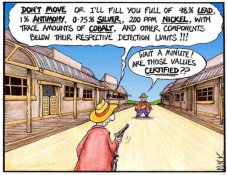No, I was asking you to quote my statement so that we both would know what you were talking about and then I could address it, but forget about it now.
Well, it was several posts earlier and I'm sorry I did not quote it. Several quick posts by others seemed to have intervened.
I've read pretty much every book that has come out in the last fifty years on photography and I've read as many scientific papers on exposure and tone reproduction that I could get my hands on. Most of the material has been consistent over the years with little change. As far as I know, there just hasn't been anything new lately. I'd love to know about it if there were.
You see, this is the problem. I have "DONE" and you have "READ". That is what I am trying to explain as the difference between our approaches. It is not so much a set of publsihed text books as it is the methodology taught to us at Kodak.
The principles of psychophysical testing are still valid. Human physiology hasn't changed that much in the last few years. There hasn't been much in the way of advances in tone reproduction theory in the last 60 years. They figured it out. One of two papers I have available to anyone who wants one (I've noticed you're not one of them) is from 1994 and it contains the same concepts as from the 1960s and with some small changes in variables, the 1940s. As far as I know, most of the changes with traditional photography over the last 40 years has been in manufacturing, not in exposure theory or tone reproduction theory and those are the subjects I like to cover. If you remember, I've asked you for more modern references so that I could do additional research but you had none to offer.
This is not entirely so if you read what Sandy King and other say, and the evidence is in the work of AA which is cited. Even fashions change.
Not modern enough is quite a statement to make without evidence. You might have noticed that when I state something as factual, I will include a reference source and often times a quote, otherwise it's just like an opinion. And everyone has one of those. I like the saying that extraordinary statements require extraordinary proof. You might want to consider giving that a try.
What will you do when a new author publishes, or an old author publishes here? Ask him/her to cite something? The new author, if going against conventional wisdom cannot cite anything and the old author falls back on old arguments adding new where they can with no citations. The work you have cited or posted here, I was doing in 1965 in the lab, often with my own coatings. I was learning by doing. I said that much of what you posted was good and correct, but did not account for the changes in films and papers in the last 40 years, and others have pointed out that the style of photography has changed as well, a factor I had forgotten to cite here. Even so, you seem to want to dismiss Sandy King and the others with less than a wave of the hand.
Oh, the "I'm from Kodak, who the hell are you?" act is desperate and despicable. We're done here.
I was citing my credentials only to show that I have had some experience in this field by actually doing the design work on such products. I hasten to add though that it is true that unfortunately Stephen Benskin was totally under our radar. We had working with us many members of the ANSI committees. That was a fact of life at Kodak, Ilford, Agfa and Fuji and I have met many of those very good scientists and engineers as well. Those are the people that are important to me, from all companies.
I have had access to them at many SPSE meetings or in most cases, with the Kodak people, I could walk down the hall and spend an hour with one of our experts on a thorny problem. I had no need, nor did any of us have a need to read literature which fell far outside the normal journals. See here:
http://facweb.cs.depaul.edu/sgrais/color_context.htm
or here:
http://books.google.com/books?id=8_...Ag#v=onepage&q=bartleson and breneman&f=false
or here:
http://www.scribd.com/doc/15758809/Daan-Zwick-The-Effects-of-Viewer-Involvement-and-Experience-on-
or here:
http://ieeexplore.ieee.org/Xplore/l...042940.pdf?arnumber=4042940&authDecision=-203
These are some of the experts with whom I consulted even though the articles are a bit off topic. They are what these individuals have produced. In particular, Jim Bartleson was a colleague of mine and we often consulted on thorny imaging problems and programming problems until his sudden untimely death.
You have stated that you have read, and I have said above that I have done. I have also written! Unfortunately, those reports are in the private files of Eastman Kodak along with other reports by those very individuals who taught me much of what I have stated here. I'm sorry. Perhaps you should request permission to have access to the EK-KRL Library and see what you can find. Or, the RIT or GEH Libraries which are quite complete. Even so, confidential reports are not available.
PE



